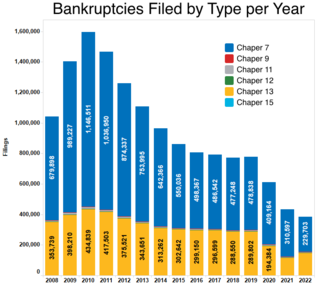Bankruptcy is a legal process through which people or other entities who cannot repay debts to creditors may seek relief from some or all of their debts. In most jurisdictions, bankruptcy is imposed by a court order, often initiated by the debtor.

In the United States, bankruptcy is largely governed by federal law, commonly referred to as the "Bankruptcy Code" ("Code"). The United States Constitution authorizes Congress to enact "uniform Laws on the subject of Bankruptcies throughout the United States". Congress has exercised this authority several times since 1801, including through adoption of the Bankruptcy Reform Act of 1978, as amended, codified in Title 11 of the United States Code and the Bankruptcy Abuse Prevention and Consumer Protection Act of 2005 (BAPCPA).
A trustee in bankruptcy is an entity, often an individual, in charge of administering a bankruptcy estate.
Consumer bankruptcy in Canada is governed by the Bankruptcy and Insolvency Act ("BIA"). The legislation is complemented by regulations, as well as directives from the Office of the Superintendent of Bankruptcy that provide guidelines to trustees in bankruptcy on various aspects of the BIA.
Bankruptcy in the United Kingdom is divided into separate local regimes for England and Wales, for Northern Ireland, and for Scotland. There is also a UK insolvency law which applies across the United Kingdom, since bankruptcy refers only to insolvency of individuals and partnerships. Other procedures, for example administration and liquidation, apply to insolvent companies. However, the term 'bankruptcy' is often used when referring to insolvent companies in the general media.

The Bankruptcy and Insolvency Act is one of the statutes that regulates the law on bankruptcy and insolvency in Canada. It governs bankruptcies, consumer and commercial proposals, and receiverships in Canada.
The Parliament of Canada has exclusive jurisdiction to regulate matters relating to bankruptcy and insolvency, by virtue of Section 91(2) of the Constitution Act, 1867. It has passed the following statutes as a result:
Bankruptcy in Irish Law is a legal process, supervised by the High Court whereby the assets of a personal debtor are realised and distributed amongst his or her creditors in cases where the debtor is unable or unwilling to pay his debts.

Commercial insolvency in Canada has options and procedures that are distinct from those available in consumer insolvency proceedings. It is governed by the following statutes:

The Companies' Creditors Arrangement Act is a statute of the Parliament of Canada that allows insolvent corporations owing their creditors in excess of $5 million to restructure their business and financial affairs.

Sun Indalex Finance, LLC v United Steelworkers, 2013 SCC 6, arising from the Ontario courts as Re Indalex Limited, is a decision of the Supreme Court of Canada that deals with the question of priorities of claims in proceedings under the Companies' Creditors Arrangement Act, and how they intersect with the fiduciary duties employers have as administrators of pension plans.

The Winding-up and Restructuring Act ("WURA") is a statute of the Parliament of Canada that provides for the winding up of certain corporations and the restructuring of financial institutions. It was passed in 1985, and has been amended since. Predecessors of the act date back to 1882.

Newfoundland and Labrador v AbitibiBowater Inc, 2012 SCC 67 is a ruling by the Supreme Court of Canada dealing with whether an obligation incurred under regulatory action constitutes a claim under the Companies' Creditors Arrangement Act, thus becoming subject to a stay of proceedings.

Reference Re Companies' Creditors Arrangement Act is a decision of the Supreme Court of Canada on the constitutionality of the Companies' Creditors Arrangement Act as part of the bankruptcy and insolvency jurisdiction of the Parliament of Canada.

Belmont Park Investments PTY Ltd v BNY Corporate Trustee Services Ltd[2011] UKSC 38, [2012] 1 All ER 505, [2012] 1 AC 383 is a UK insolvency law case, concerning the general principle that parties cannot contract out of the insolvency legislation. The principle has two key aspects, of which the Supreme Court of the United Kingdom ruled that only the first was relevant on the facts of the case:
- The anti-deprivation rule, which is aimed at attempts to withdraw an asset on bankruptcy or liquidation or administration, thereby reducing the value of the insolvent estate to the detriment of creditors.
- The pari passu rule, which reflects the principle that statutory provisions for pro rata distribution may not be excluded by a contract which gives one creditor more than its proper share.

Caisse populaire Desjardins de l'Est de Drummond v Canada is a Canadian income tax law case of the Supreme Court of Canada that has wide-ranging application to other areas of federal and provincial jurisdiction when dealing with cash collateral arrangements and security interests.
The anti-deprivation rule is a principle applied by the courts in common law jurisdictions in which, according to Mellish LJ in Re Jeavons, ex parte Mackay, "a person cannot make it a part of his contract that, in the event of bankruptcy, he is then to get some additional advantage which prevents the property being distributed under the bankruptcy laws." Wood VC had earlier observed that "the law is too clearly settled to admit of a shadow of doubt that no person possessed of property can reserve that property to himself until he shall become bankrupt, and then provide that, in the event of his becoming bankrupt, it shall pass to another and not to his creditors."
Anguillan bankruptcy law regulates the position of individuals and companies who are unable to meet their financial obligations.

Reference Re Farmers' Creditors Arrangement Act is a decision of the Judicial Committee of the Privy Council on the constitutionality of the Farmers' Creditors Arrangement Act as part of the bankruptcy and insolvency jurisdiction of the Parliament of Canada.

Peace River Hydro Partners v Petrowest Corp, 2022 SCC 41 is a case of the Supreme Court of Canada on the applicability of arbitration laws on the authority of a receiver appointed under the Bankruptcy and Insolvency Act.






